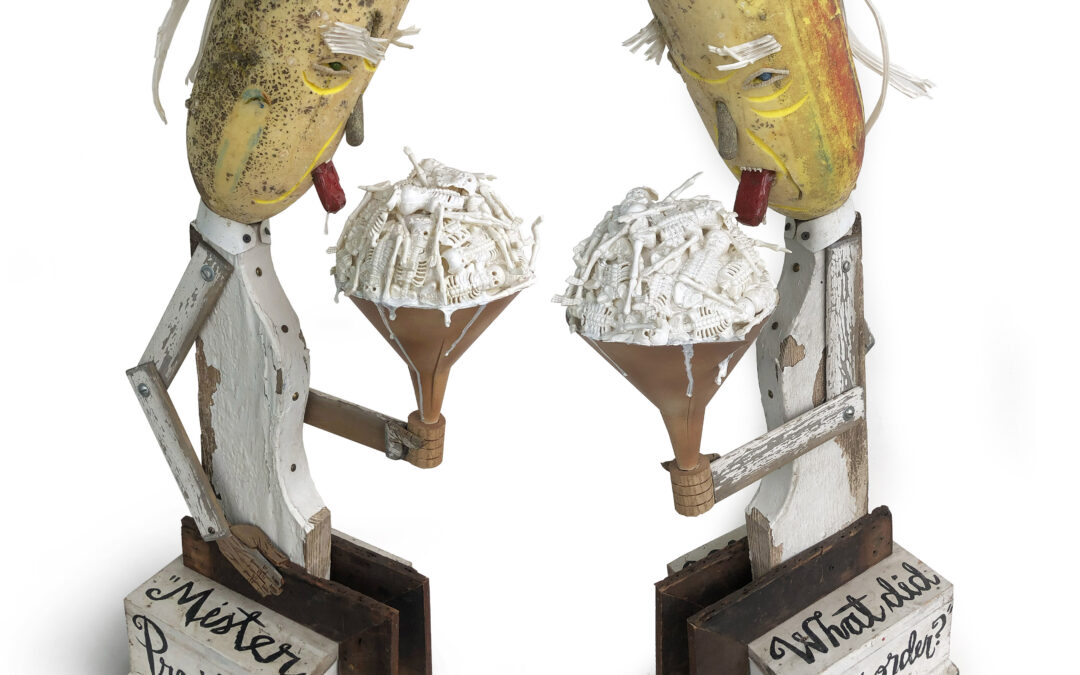(“Mr. President” by Sam Hundley)
By Betsy DiJulio
For their summer show at Assembly, Asa and Kira Jackson of the Newport News CAN Foundation (Contemporary Art Network) assembled three Hampton Roads-based artists who have long made art from found and manipulated objects: Sam Hundley, Karen Freidt, and Wade Mickley. But found objects alone could have easily come off as a pretty thin premise for a show.
Fortunately, these curators who program Assembly’s public spaces knew what they were doing by bringing together these three diverse artists who have in common more than the origin of their materials. In ways that are playful on the surface, all of them probe the frailties and vulnerabilities of the human species, while also heralding some of our more noble aspects.
Sam Hundley has been called an American Scrap Artist, though he carves a mean block print with a highly distinctive style. Retired in 2009 from his 40+ year tenure as a newspaper artist, Hundley seamlessly transitioned to full-time engagement as an artist. Piles of junk on his studio floor—both found and given to him by friends—and his subconscious mind collaborate to create sculptural relief portraits of people and animals, the latter the main characters of two illustrated children’s books. “Anything can be anything,” as he says.
Subjects run the gamut from personal friends to artists, celebrities, politicians, and sports figures rendered with exaggerated, but recognizable, features ingeniously fashioned from pieces and parts of metal hardware and equipment, kitchen tools, wooden signs and architectural features, driftwood, cans, screens, and various and sundry other castoffs with chipped and faded paint and patinas. Equal parts empathy, irony, and exposure, Hundley’s oeuvre will make you think…but it won’t tell you what to think.
Karen Freidt recently retired after a long career working at NASA, first as a graphic designer—where she met her husband Mickley, who still works there—and then in a succession of functions related to creativity and innovation in the workplace. Having not created any assemblage work of late, she admitted to feeling, in some ways, like she was “going backwards” for this show, as she was “already working on other ideas.”
Laughing that she should “probably give things more thought,” she reflects that “Some are deep, and some are just for fun.” But a curiosity about materials drives both. The “fun” pieces include carved toy-like heads with exaggerated features, especially hairdos, and expressions to match. Embellished with found and purchased objects and materials, Freidt dry brushes layered colors over black underpainting creating surfaces that are subtle and luscious with exquisite texture.
A new series of 24 x 36” prints on metal relies not on the assemblage of found objects, but of many layers of imagery, tools, and media. In these botanical-based pieces, the artist deep dives into metaphorical waters as she explores the ravages of Alzheimer’s on her mother and those who love her. Each print begins as linocuts that Freidt photographs, uploads onto her computer, and then manipulates, endlessly layering and adjusting the transparencies and textures.
In response to the question, “Why plants?”
She responded: “I see plants representing growth, beauty, and a regeneration of life. I believe the dementia, although horrific, is another phase of life, a transition to the next. My parents and I spend a lot of time and find comfort in our gardens…it felt natural to use them. I hadn’t thought about what they represent or why I use them until you asked. Deep down I know there are reasons why I make certain creative choices, but during the process I tend to trust my instincts and don’t always know why I made them until much later. I absolutely love my garden. It is so reactive: you show it some love and it gives back tenfold, just like with my mom.”
Mickley, too, shared that when the possibility for this show arose, he was “going in a different direction,” so none of his 12 pieces were created especially for this exhibition. Of late, he has been “playing with textiles,” especially painters’ tarps. Though he bought a sewing machine, he is still “not sure where that’s going.”
His work is a balance between intuitiveness and intentionality. A “word person,” he keeps a list on his phone of words he hears, say, while listening to a podcast, that seem ripe for visual exploration. Old sayings, phrases, and questions can send him straight down a rabbit hole. What emerges is often the result of an inner monologue so that the work becomes a way of understanding himself in a kind of “inside-out” approach, though the pieces speak universally.
Working at a computer all day means that he especially enjoys the handmade aspects of his assembled work, though the end products are most often a fusion of both a hand-crafted and a more precise approach, like the 150 or so hand-applied vinyl “drops” in some of his pieces. He enjoys the repetitive nature of that process, describing himself as a somewhat anxious person for whom working with his hands quiets his mind.
Some of Mickley’s most recognizable work incorporates 45-rpm vinyl records. Influenced by illustration generally, he responds not only to the music, but to the colors, graphics, and fonts on the center labels. Punctuated with bright colors, his highly symmetrical signature style involves cutting the 45s so that the black plastic plates of the records can be aligned to function like a wide line or band with which he can “draw” arms, legs, and other abstract features.
The public is invited to engage with the work of all three artists in the public spaces of Assembly’s five-story office campus in downtown Norfolk where both human connection and the cool factor are equally on display.
WANT TO SEE?
Assemblage
Through August 18
Assembly
400 Granby Street, Norfolk




